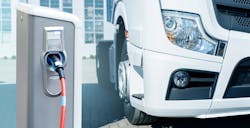There is no escaping the attention surrounding electric vehicles (EVs). But the decision to add electric trucks to your fleet is one that requires careful consideration, according to Sean Storey, NationaLease’s vice president of capital equipment.
Speaking at a recent NationaLease maintenance managers’ meeting, Storey said, “Before you plan to order an EV, do your homework to make sure you are ready.” At this point in their development, EVs are not right for every trucking application, he noted, so you want to make sure you make the appropriate decision about how they fit in your fleet.
The first step in determining if you should order an EV is to understand how it will be used. The operating range of EVs is different than that of your standard diesel-powered truck, so the range you expect the truck to travel is a critical element. The North American Council for Freight Efficiency has information on use cases where EVs make sense. They generally feature low-mileage, short-haul operations.
See also: Leveraging BEV benefits on urban routes
If EVs fit with your duty cycles, the next step is to assess your charging needs. Storey said it can take a minimum of one year to get the needed infrastructure in place. Factors to consider include determining where the truck will be domiciled and where charging stations will be located on the property. In addition, EV manufacturers are facing the same supply chain constraints as manufacturers of diesel trucks, so it could take some time to get your truck delivered.
The proper infrastructure is critical to the successful deployment of EVs. It is best to gather all the key players together to develop a plan for deploying EVs. This should include the EV maker, the charging station vendor, the local power company, a contractor, the landowner, an expert on EV grants and incentives, and your funding source.
“While you are assembling your infrastructure team, you should be speaking to the EV OEM or dealership contacts regarding the product’s availability, timeline for delivery, and costs,” Storey said.
It is vital to ensure infrastructure is in place before setting EV equipment orders for construction and delivery. Having an EV but no place to charge it is a recipe for disaster.
See also: Working together to ensure EV servicing safety
You also should begin investing in training for your technicians to ensure they are qualified to work on EVs once they arrive at your facility. If you outsource service, make sure your service provider has technicians qualified to work on these vehicles.
While we are still in the infancy of electric trucks, EVs likely will become a bigger part of fleets in the future. Being prepared is the best way to ensure success.
Jane Clark focuses on managing the member services operation at NationaLease as vice president of member services. She works to strengthen member relationships, reduce member costs, and improve collaboration within the NationaLease supporting groups.
About the Author
Jane Clark
Senior VP of Operations
Jane Clark is the senior vice president of operations for NationaLease. Prior to joining NationaLease, Jane served as the area vice president for Randstad, one of the nation’s largest recruitment agencies, and before that, she served in management posts with QPS Companies, Pro Staff, and Manpower, Inc.
